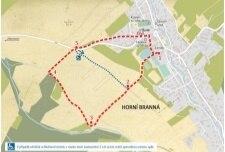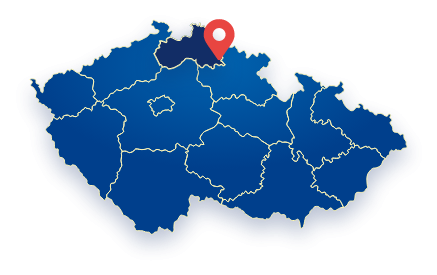Zastavení 5
Tabule – Zvířata
V horských lesích Krkonoš a jejich podhůří žily v minulosti čtyři velké druhy šelem, které byly vyhubeny člověkem. V polovině 18. století vymizel z Krkonoš medvěd hnědý, začátkem 19. století rys ostrovid, později vlk obecný a koncem 19. století kočka divoká.
Z šelem tady v současnosti žijí tchoř tmavý, lasice kolčava, lasice hranostaj, kuna lesní, kuna skalní, jezevec lesního a největší krkonošská šelma, liška obecná. Ze savců jmenujme alespoň plcha velkého, plšíka lískového, myšici lesní, veverku obecnou, zajíce polního, srnce obecného a prase divoké.
Do okolních lesů sestupuje z hor občas i král horských lesů, jelen evropský. Daleko více je zde však zvěře srnčí.
Suchá kamenitá místa a výhřevné paseky jsou domovem ještěrky živorodé, slepýše křehkého či zmije obecné, která vzácně vytváří i zcela černou formu.
Louky a paseky zdobí v letních dnech krásné babočky, perletovci, okáči, ohniváčci, modrásci, bělásci a žlutásci. Dalšími motýly jsou zde otakárek fenyklový, batolec duhový, batolec červený a bělopásek topolový.
Z brouků je zde hojně nosorožíků kapucínků, tesaříků
a střevlíků různých druhů. V lesích žije také mohutný chrobák velký.
Station 5
Tafel – Tiere
In den Wäldern des Riesengebirges und seinem Vorland lebten in früheren Zeiten vier Arten von Raubtieren, die vom Menschen ausgerottet wurden. In der Hälfte des 18. Jahrhunderts verschwand der Braunbär aus dem Riesengebirge, zu Beginn des 19. Jahrhunderts der Luchs, später der Wolf und am Ende des 19. Jahrhunderts die Wildkatze.
Von den Raubtieren leben hier heute der Waldiltis, das Mauswiesel, der Hermelin, der Baummarder, der Steinmarder, der Europäische Dachs und das größte Raubtier des Riesengebirges, der Rotfuchs.
Von den Säugetieren wollen wir zumindest folgende nennen: den Siebenschläfer, die Haselmaus, die Gelbhalsmaus, das Eichhörnchen, den Feldhasen, das Reh und das Wildschwein. In die Wälder kommt aus den Bergen zuweilen auch der König der Bergwälder, der Rothirsch. Wesentlich häufiger ist hier jedoch Rehwild anzutreffen.
Trockene steinige Plätze oder warme Lichtungen sind die Heimat der Waldeidechse, der Blindschleiche oder der Kreuzotter, die zuweilen auch in völlig schwarzer Form vorkommt.
Wiesen und Lichtungen werden in den Sommertagen von schönen Schmetterlinge geschmückt wie z.B. dem Kleinen Fuchs oder dem Perlmutterfalter, von Bläulingen, Weißlingen und Gelblingen, vom Schwalbenschwanz, dem Großen und dem Kleinen Schillerfalter oder dem Großen Eisvogel.
Von den Käfern sind hier in großer Menge Nashornkäfer, Bockkäfer, Laufkäfer und Mistkäfer anzutreffen.
Stand 5
Board – Animals
In the past four large carnivorous animal species, which were later extirpated by man, used to live in the forests of the Krkonoše Mountains and their foothills. They were the brown bear, which disappeared from the Krkonoše Mountains in mid-18th century followed by the Eurasian lynx at the beginning of the 19th century and later, at the end of the 19th century by the gray wolf and wildcat.
Among the carnivorous animals living here now, we can mention the European polecat, the least weasel, the stoat, the pine marten, the beech marten, the European badger, and the largest carnivore of the area, the red fox. Concerning mammals living here, we can mention at least e.g. the edible dormouse, the hazel dormouse, the yellow-necked mouse, the red squirrel, the European hare, the roe deer and the wild boar. Sometimes, even the king of the mountains forests, the red deer, descends into the local woods. However, roe deer are much more common here.
Dry and stony places and warm clearings are the home of the viviparous lizard, the slowworm, or the common European adder, which rarely also occurs in its black colour pattern variety.
On summer days the meadows and clearings are full of beautiful butterflies such as the vanessa, argynnis, satyrinae, lycaenini, lycaeninae, pieridae and gonepteryx. You can also spot here the papilio machalon, the purple emperor, the lesser purple emperor and the limenitis populi.
The common beetle species living here are e.g. the rhinoceros beetle and different representatives of the longhorn beetles and the ground beetles. In the local forests you can also see the geotrupes stercorarius.
Przystanek 5
Tablica – Zwierzęta
W górzystych lasach Karkonoszy i ich pogórza w przeszłości żyły cztery gatunki dużych zwierząt drapieżnych, które zostały wytrzebione przez ludzi. W połowie XVIII wieku z Karkonoszy znikł niedźwiedź brunatny, na początku XIX wieku jego los podzielił ryś, później wilk, a pod koniec XIX wieku także żbik.
Z drapieżników dziś żyje tu tchórz, łasica pospolita, gronostaj, kuna leśna, kuna domowa, borsuk i największy karkonoski ssak drapieżny – lis. Z pozostałych ssaków wymieńmy choć popielicę szarą, orzesznicę leszczynową, mysz leśną, wiewiórkę, zająca szaraka, sarnę i dzika. W okoliczne lasy schodzi też czasami z gór król górskich lasów – jeleń szlachetny. O wiele więcej jest tu jednak saren.
Suche, skaliste miejsca i ciepłe polany są miejscem bytowania jaszczurki żyworodnej, padalca czy żmii zygzakowatej, która czasami bywa ubarwiona na czarno.
W letnim okresie łąki i polany udekorowane są pięknymi motylami z rodziny rusałkowatych, jak skalnik prozerpina, mieniak strużnik, mieniak tęczowiec czy pokłonnik osinowiec, a także z rodziny modraszkowatych i bielinkowatych. Gości tu też paź królowej.
Spośród chrząszczy częsty jest rohatyniec nosorożec, chrząszcze z rodziny kózkowatych i biegaczowatych. W lasach żyje także potężny żuk gnojowy.





